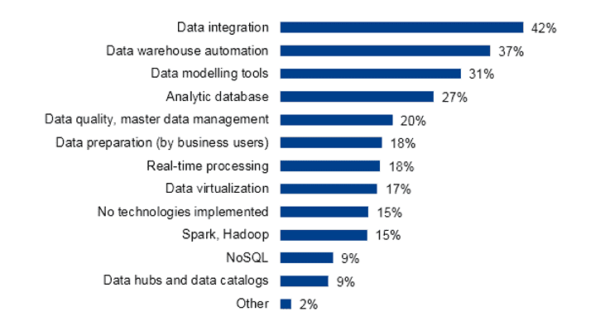Data Integration is Crucial for Modernizing the Data Warehouse
The Business Application Research Center (BARC) publishes “The Data Management Survey 19”, a new study based on a recent worldwide survey of 782 data management software users. The survey results provide insights into current approaches to data warehouse modernization as well as a comparison of 11 leading data management products.
It is generally acknowledged that 70-80 percent of the effort involved in data warehousing is spent on data integration processes. It is therefore natural that users should try to modernize their data warehouse environments by means of ETL automation and data warehouse automation. According to The Data Management Survey 19, data integration technologies are still the main technology used for this purpose (by 42 percent of respondents), closely followed by data warehouse automation solutions (37 percent) and data modeling tools (31 percent).

Specialist data warehouse automation software rated better than data integration tools
The Data Management Survey 19 reveals that data warehouse automation is one of the top three application scenarios for data integration tools, alongside classic tasks such as loading data marts and enterprise data warehouse systems. A comparison between data warehousing automation specialists and data integration tools found that user ratings of specialist software were better overall for data warehouse automation, especially in terms of developer efficiency and time-to-market. However, data integration tools did not come off too badly in the comparison.
Leaders set a trend for using analytical databases
There is a variety of approaches to modernizing the data warehouse and addressing new analytical requirements. BARC‘s study shows that companies with a flexible data and process architecture or agile interoperable data services (termed as “leaders“ for the purposes of this research) favor a central approach – such as building an enterprise data warehouse – rather than using additional data marts. According to the survey findings, one in three leaders has already migrated to a central approach.
The implementation of an enterprise data warehouse requires powerful databases that are able to scale with large data volumes and a multitude of different workloads while remaining both manageable and highly performant. As a result, leaders use analytical databases much more frequently (41 percent) than average (27 percent). Other companies are more likely to rely on data marts for modernization.
About the survey
The Data Management Survey 19 is the first edition of BARC’s annual study of the data management software market. The study is based on a worldwide survey of 782 data management experts, which addressed questions about their software selection, implementation and usage. Detailed feedback on 11 data management products is analyzed and compared. A total of 690 participants answered a series of detailed questions about their use of a named product while over half answered a further set of more general, product-agnostic questions. To perform your own interactive product comparisons based on the survey data, visit:
Klicken Sie auf den unteren Button, um den Inhalt von bi-survey.com zu laden.
